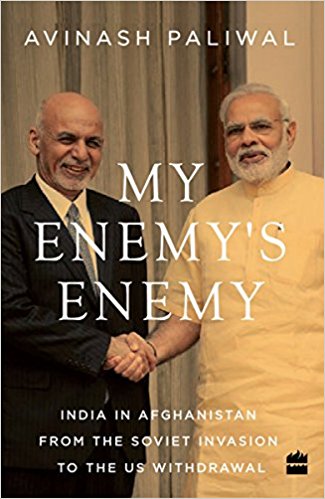Historians call Afghanistan the graveyard of empires. In future, they may label it the training ground of Indian statecraft. Avinash Paliwal’s book on Indian policy towards Afghanistan describes how, despite being dealt a poor hand by geography, military capacity and excessive caution, New Delhi has been able to remain a Great Game player for two decades. If the yardstick is ensuring a pro-Pakistani regime does not rule in Kabul, India can even claim success. However, Paliwal’s account makes it evident much of this success is due to Washington’s flip-flops, Pakistani bungling and simple luck, factors outside India’s control.
Before the United States overthrew the Taliban regime in 2001, India had a spotty Afghan record. It supported the brutal Soviet invasion, watched Pakistan nearly colonize Afghanistan and redeemed itself only by becoming a Northern Alliance patron. New Delhi’s pleasure at seeing the Taliban fall was eclipsed at the uneasy but robust Washington- Islamabad military axis that followed. India, having little to contribute to the military campaign in Afghanistan, found itself pushed to the margins.
India was slow to warm-up to the new Afghan president, Hamid Karzai. The uneasiness was mutual. Karzai “was prone to thinking that Afghanistan was a victim of India-Pakistan rivalry.” By 2004, however, New Delhi was fully committed to the Karzai regime, seeing him as the best bulwark against a return of the Taliban and, therefore, Pakistani influence. India rolled out its largest-ever foreign aid programme for Afghanistan. Yet Karzai shocked India in 2007 when he tried to entice the Taliban with an olive branch. It was a reminder that in a war zone, a determinedly civilian power like India was not a core player.
Things got worse. India’s influence in Afghanistan was reduced to a shadow in the period from 2009 to 2015 as US President Barack Obama moved towards full US military withdrawal. Part of that strategy was to invite the Taliban to Kabul and leave Afghanistan to Pakistan’s tender mercies.
Just when it looked like the Great Game was over for India, Osama Bin Laden was killed in Pakistan and the Islamic State arrived on the world stage. As the US soured on Pakistan, India saw its star rise again. That didn’t stop Karzai from making another overture to the Taliban in 2015. As before, Pakistan-cum-Taliban rejected the offer.
Today, of course, the Trump administration has recommitted US military power to fight back the Taliban and put the Kabul regime in pole position again – much to India’s glee.
To remain relevant amid all these twists and turns, New Delhi has repeatedly diluted its policies. It moved from opposing any sort of Taliban reconciliation to supporting peace talks that limited Pakistan’s influence. By 2009, India was trying to reach out to the Taliban.
Paliwal argues Pakistan is “loathed, dreaded, hated but also ironically an awe-inspiring neighbour” for most Afghans. While polls show India has the highest approval rating of any country among Afghans, they see India as “a reluctant and indecisive regional power.” Karzai may have disliked Pakistan but the ground reality meant he had to keep trying to strike a deal with them – a viewpoint adopted by his successor President Ashraf Ghani. India’s unwillingness to send troops and inability to provide weapons were a key reason Afghans often ignored its advice on reconciliation. More than anything else, it has been Pakistan’s curious rejection of repeated Afghan overtures that has kept India in play. “Pakistan keeps handing Afghanistan to us on a silver platter,” is the refrain among Indian officials.
Paliwal has taken pains to try and trace New Delhi’s policy back to specific groups of Indian policymakers, many of whom he has interviewed. He argues there are two distinct schools of Afghan policy. One school he calls “conciliators” who argue India “should focus on whoever comes to power in Kabul without fear or favour.” The other school he labels “partisans,” those who measure all things Afghan on the basis of their proximity to Pakistan. Both policies were often practised at the same time. It can also be argued these supposed schools were more tactical responses to shifting geopolitical circumstances.
The most striking lapse in the book is an understanding of India’s deep-seated opposition to the Taliban. Paliwal feels the Taliban regime sought to play a positive role in ending the IC-814 airline hijack. As has been recounted in Who Killed Daniel Pearl? and elsewhere, when the airliner landed in Kandahar the Tailban’s actions were dictated by Pakistani intelligence officers. Indian ministers spoke of the “jihad machine” run jointly by Rawalpindi and the Taliban to sustain Kashmir’s violence. India would be more sanguine about some elements of the Taliban coming to power in Kabul today, but the origins of New Delhi’s hostility are poorly delineated.
The wealth of information in the book will overwhelm some lay readers. But it is worthwhile to wade through its pages. There are many side stories: the Afghan factor in India’s role in Balochistan, how New Delhi encouraged Beijing to become more involved in Afghan peace-making and why Iran opposed India building a dam for the Afghans. Despite flaws, this is the definitive account of India’s contemporary Afghan policy – and a reminder of how hard it is to exert power even a few hundred miles from one’s borders.



Leave a reply